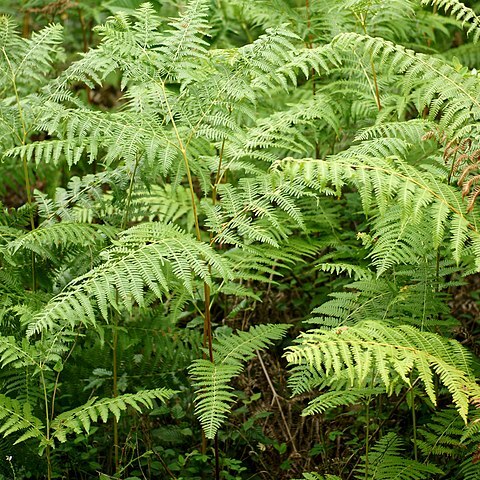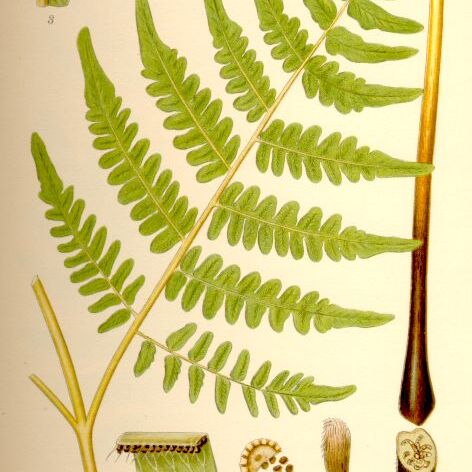Plants terrestrial, often forming colonies or thickets. Stems subterranean, slender, long-creeping; hairs pale to dark, jointed; scales absent; true vessels present (absent in other Dennstaedtiaceae genera in the flora). Leaves widely spaced, broadly deltate, 0.5--4.5 m. Petiole glabrous to short-hairy, without prickles, with stem buds near base, vascular bundles numerous, U-or O-shaped in cross section. Blade 2--4-pinnate, rachis and costae grooved adaxially; rachis without prickles; nectaries at base of proximal and sometimes distal pinnae. Segments pinnately divided, ultimate segments ovate to oblong to linear, base extending proximally on costae (decurrent) or proximally (surcurrent), margins entire. Veins free or joined at margin by commissural vein beneath sori, pinnately 2--3-forked. Sori ± continuous, covered by recurved, outer false indusium and obscure, extrorse, inner true indusium. Spores tetrahedral-globose, trilete, very finely granulate. x = 26.
Petiole coarse, ± erect and stem-like, with several vascular bundles that unite distally to form a gutter-shaped bundle; blade ternate-pinnately 2-3 times compound, the ultimate segments pinnatifid but otherwise entire; pinnae opposite or nearly so; pinnules alternate, their segments oblong to linear with revolute margins; veins “free” but connected by a submarginal vascular strand on which the contiguous and confluent linear sori are borne, these protected by the recurved, modified lf-margin and a minute or often nearly obsolete hyaline inner indusial flap of tissue; coarse ferns with widely creeping rhizomes and coriaceous, deciduous lvs, the rhizome and often also the lvs provided with septate hairs. 1–several, by interpretation, cosmop.
Terrestrial ferns. Rhizomes long-creeping, subterranean, hairy. Fronds usually large, 2–4-pinnate. Veins free, except for a marginal connection. Scales absent; hairs present on fronds and rhizomes. Nectaries present at base of pinnae. Sori ± continuous around margins, borne on the connecting vein, lacking paraphyses, protected by reflexed usually membranous lamina margins and by an inner membranous indusium which may be poorly or sometimes not developed. Spores trilete, irregularly granulose. [See also Green (1994: 588, 590).]
Sori continuous along margins of segs, protected by reflexed margin and a true indusium (sts obsolete). Sporangia with slender stalks; spores tetrahedral, smooth. Rhizome far-creeping and branching, deep seated, solenostelic, clad in hairs. Frond pinnately compound, coriac., ± hairy; veins free, simple or forked, connected by marginal nerve. Terrestrial, subcosmopolitan. The forms treated by some as one sp. with a number of vars, by others as consisting of a number of closely related spp.
veins free; inner indusium present


